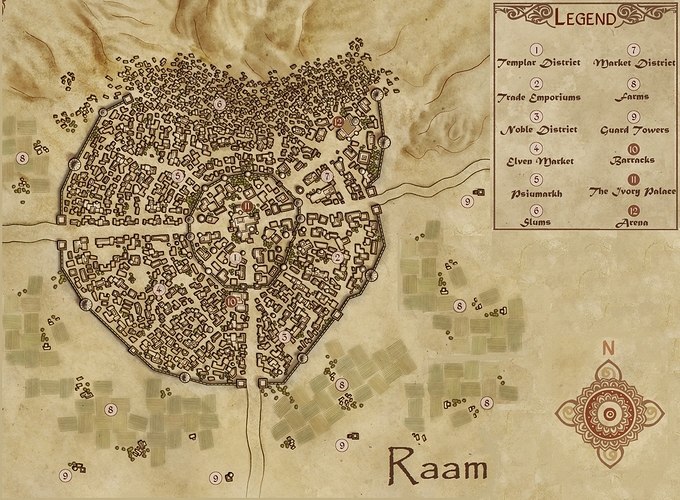I maintain in my campaign that Athas, and the events occurring throughout the Tablelands, follow the Original 2ed AD&D Boxed Set.
All seven city-states remain under the control of the Sorcerer-Kings and Queens, and the ruler of Raam, Abalach-Re, retains her position on the throne, although it is a very delicate position she hold; the free citizens of Raam (to include the noble caste, the merchant houses, and the resident elves) continue to speak of organizing a rebellion and openly praise the last attempt to overthrow their queen.
I have seen several other maps of Raam, some “official,” some fan-made; this is simply my version, using both material and graphics I have collected throughout the years.
The center of Raam is dominated by a rocky outcropping known as Queen’s Hill. On the highest point of this hill sits the Ivory Palace; a spectacular display of the sorcerer-queen’s power and dominance. Surrounding The Ivory Palace is the Templar District, a sprawling complex of administrative buildings, courts, records halls, and living quarters for the Templar caste. Collectively, the Ivory Palace and the Templar District are referred to as The Official Quarter. Encircling both the palace and the Templar District is an imposing wall, defensive breastworks, and bristling ditches, access through which is tightly controlled by well-paid guards, trained Templars, magic and psionics.
The Ivory Palace: The Sorcerer-Queen’s palace is the jeweled crown atop Queen’s Hill. A fabulous citadel constructed of ivory and alabaster, and inlaid with silver tracery, it is a testimony to Abalach-Re’s excess. The palace contains perhaps a hundred rooms or more, including great halls, ballrooms, kitchens, bedrooms, treasure vaults, and more. While an impressive defensive fortress, the Ivory Palace is more a tower of exile and isolation for Abalach-Re. Beneath the sorcerer-queen’s dwelling, extensive caverns house her prized armory - a collection of weapons, armor and other battle equipment.
Market District: In a wide plaza on the east side of the city-state, where the Road of Kings meets the Draji Road, the city market of Raam and the Trade Emporiums lie, with very little distinction between the two. Filled with store-fronts, booths and tents displaying dozens and dozens of merchants’ and artisans’ goods, much of the Market remains vibrant and bustling every day.
The Elven Market: This portion of Raam houses and provides the nomadic race of Elves a place to peddle what goods and materials they can. The elven market, however, serves a more important role as a meeting place and a skirmish ground between mansabdar (the feared corrupt public police force of Raam) factions.
The Psiumarkh: This establishment is the most prestigious of the psionic schools in Raam, and in all of the Tyr Region. The school can trace its founding back to the founder of modern psionic principles, Tarandas, over 900 years ago. The Psiumarkh has always maintained strict neutrality in the struggles that afflict Raam, allowing them not to anger any of the city’s powerful factions.
The Barracks: Located just outside the Official Quarter, close to the Ivory Palace, the Barracks are a multi-story building used to quarter the elite warriors and officers of the Raamish army.
The Arena: Not unlike arenas in most other city-states, the arena is nothing extraordinary. There is the main arena surrounded by seating and cages. And like other arena found throughout Athas, some gladiators and contestants enter the pit of death and walk out to live another day, while others do not.
